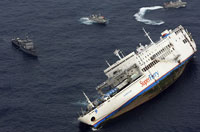 I’ve always been struck by the tragedy that those most in need of ferry service are often also most at risk. We have seen recent ferry accidents in the Philippines with the sinking of the Superferry 9 resulting in nine deaths, in Tonga with the loss of 73 passengers with the sinking of the Princess Ashika and earlier this year the deaths of an estimated 250 passengers when a ferry capsized near Sulawesi, Indonesia. Last year, MV Princess of the Stars, capsized in the Philippines with the loss of 800 lives.
I’ve always been struck by the tragedy that those most in need of ferry service are often also most at risk. We have seen recent ferry accidents in the Philippines with the sinking of the Superferry 9 resulting in nine deaths, in Tonga with the loss of 73 passengers with the sinking of the Princess Ashika and earlier this year the deaths of an estimated 250 passengers when a ferry capsized near Sulawesi, Indonesia. Last year, MV Princess of the Stars, capsized in the Philippines with the loss of 800 lives.
Barista Uno writing in the Marine Café blog in the Philippines has an intriguing perspective and insight on the sinking of the Superferry 9 and similar casualties:
The unseen tragedy behind Superferry 9
The loss of a single human life is tragic. The loss of nine, more so. That’s the number of confirmed dead in the 6th September sinking of the Superferry 9 in the southern Philippines, the rest of the ship’s 968 passengers and crew having narrowly escaped to tell the tale. But the real tragedy behind Superferry 9 and the long string of maritime accidents that came before is less obvious.
It is the seeming inability of Filipinos as a nation to bewail, to express outrage at, the never-ending slaughter at sea. Have Filipinos become inured? Perhaps so, but that doesn’t explain the fact that little has changed since the December 1987 Dona Paza ferry disaster that snuffed out, according to the World Almanac, 4,341 lives.
For sure, there was plenty of grief and anger (mostly from the victims’ families) in the immediate aftermath. But 22 years on, who gives a hoot? The country’s maritime regulations are still poorly enforced; interisland vessels are shabbily maintained; and no one gets as much as a slap on the wrist for causing serious mishaps.
